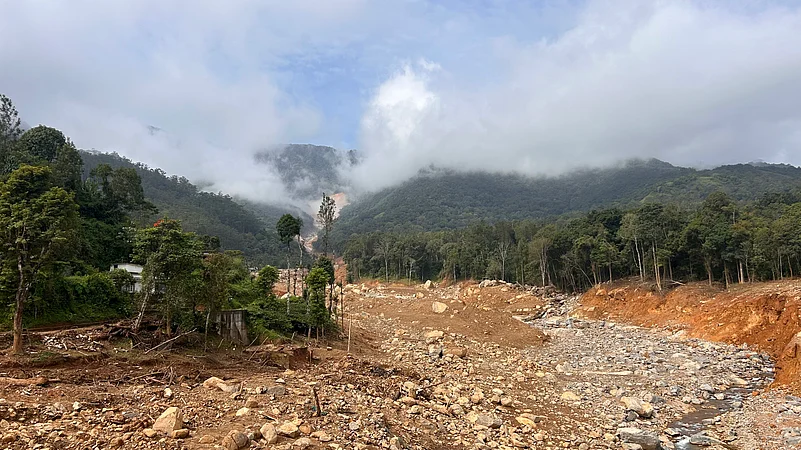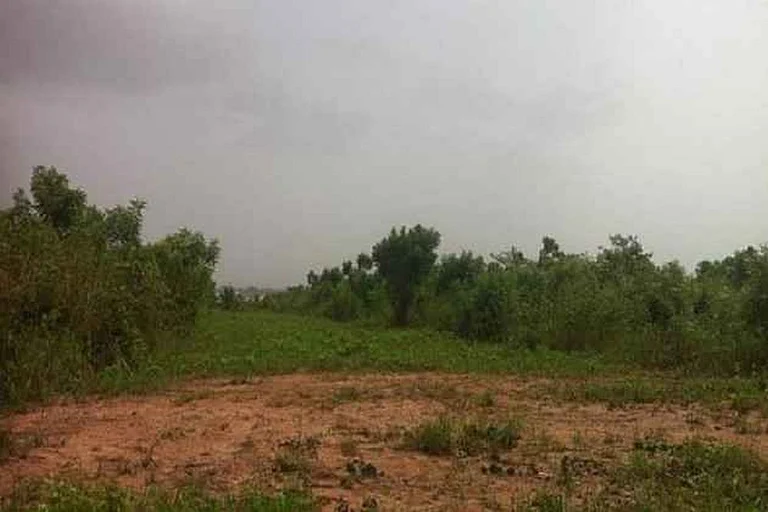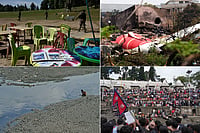A year after massive landslides buried three villages in Kerala's northern hill district of Wayanad, the skies have darkened again—and so have the lives of those who escaped with theirs.
Torrential monsoon rains are now drenching the same vulnerable slopes of Chooralmala, Mundakkai, and Punchirimattam, the epicentres of one of the worst natural disasters in the country's recent history.
In these hills, rain is no longer a blessing for the residents. It's a warning.
Ecologists tracking the Western Ghats say the risk is real and rising. "The slopes are under immense pressure," says C.K. Vishnudas of the Wayanad-based Hume Centre for Ecology and Wildlife Biology.
"The hill bases are eroding, and the weight from above is increasing. Another tragedy isn't improbable—it's imminent," he says.
Since the onset of the southwest monsoon this year, Wayanad has recorded over 4,000 mm of rainfall, significantly higher than previous years. If this heavy spell continues, Vishnudas warns, the chances of another catastrophic event multiply.
Several regions across the district—including Lakkidi, Kappikkalam, Sugandhagiri, Thondernad, Vellamunda, Padinjarathara, Vythiri, Meppadi, Kurumbalakotta, and Manikkunnumala—remain dangerously unstable. Many lie along the same geological fault lines that gave way last year.
But it isn't just the hills that are on the brink. So is the system meant to protect and rebuild lives?
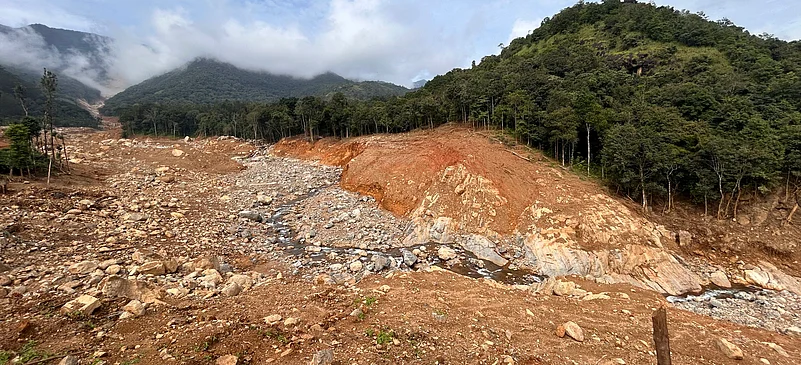
The landslides of July 2024 erased entire communities in all three locations. Churches, temples, tea stalls, homes, anganwadis—all were swept away. More than 400 people were killed; nearly 100 remain missing. What remains is silence—and grief.
Only one tribal family still lives in Punchirimattam, clinging to ancestral land. Everyone else—over a thousand families—has been dispersed into rented homes, temporary shelters, and government camps, struggling to piece together broken lives.
In March 2025, Chief Minister Pinarayi Vijayan laid the foundation for a new rehabilitation township at Elstone Tea Estate, 22 km from the disaster zone. Each family was promised a 1,000 sq. ft. house on seven cents of land, with access to schools, health centres, and other facilities.
But legal hurdles stalled the project for months. Even after the courts cleared the land, construction has moved at a crawl. Only 175 families have agreed to relocate. Another 67 chose a one-time compensation of ₹15 lakh to rebuild independently. But the area has no farmland, few jobs, and limited infrastructure. Many feel stranded, again.
"They didn't just lose houses," says Meppadi farmer leader P.T. John. "They lost livelihoods, identity, and dignity. And now, they're losing faith in the promises made to them."
In the immediate aftermath of the disaster, survivors were assured compensation, debt waivers, and new land. But a year later, many find themselves overwhelmed by debt.
According to the Janasabdam Action Council, a collective of survivors, affected families now owe over ₹22 crore in loans. The government waived ₹ seven crore in interest, but the principal remains. For those without farmland or employment, it feels like a second wave of disaster.
In Punchirimattam, Nissar Ahamed lost seven family members and all his farmland. He now owes ₹7 lakh to the Kerala State Financial Enterprises (KSFE). In Mundakkai, farmer P.V. Azeez returned from a wedding to find his home gone. He has no income, but still owes ₹3.9 lakh. "What use is a moratorium if we have nothing left to live on?" he asks.
What adds salt to the wound is the lack of clarity about the funds raised in their name. The Chief Minister's Distress Relief Fund (CMDRF) collected over ₹720 crore after the landslides. But survivors say they've seen little of it.
"Even if ₹40 lakh had been given to each affected family, that would have covered everyone with ₹400 crore," notes Shajimon Chooralmala, convenor of Janasabdam. "Instead, ₹755 crore was handed to a single construction company—without transparency, without consent."
To the horror of survivors, a new kind of intrusion has emerged—tourists. Over the past months, thrill-seekers, influencers, and vloggers have descended on the landslide sites, turning the ruins into backdrops for content.
"They come to stare at our grief," says Madathil Vijayan, who lost several family members. "This is not a tourist spot. It's a grave."
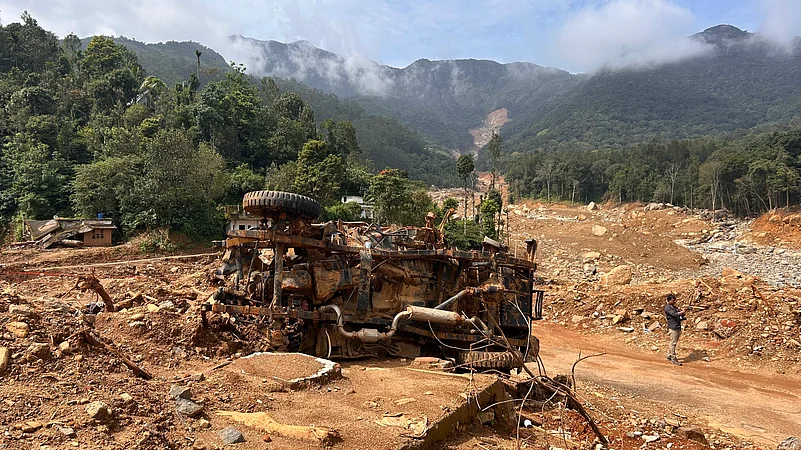
After public outrage, local authorities set up police checkpoints and restricted access. But residents now demand a permanent ban on tourism in the affected zones. A formal request is pending before the Chief Minister.
Even as the rehabilitation project stagnates, infrastructure contracts have surged. A ₹48 crore road restoration project has been sanctioned to improve access to the disaster zone. But environmentalists fear the work could destabilise the terrain further.
"Rehabilitation is at a standstill, but road projects are racing forward," says N. Badusha of the Wayanad Prakrithi Samrakshana Samithi. "This isn't just insensitive—it's dangerous."
Revenue Minister K. Rajan defends the construction as essential for agriculture and forest conservation. But for those awaiting homes and jobs, it's another sign of misplaced priorities.
The Janasabdam Action Council has refused to back the new township project unless four core demands are met: Restoration of the original promise of 10 cents of land per family, ₹40 lakh compensation for those who opt out, full loan waivers for disaster-hit families and Government jobs for the 14 children orphaned by the landslides
"These aren't favours—they are rights," says environmentalist Sridhar Radhakrishnan. "Bottom-up rehabilitation is necessary, not top-down." The state must listen to the people it failed."
The tragedy of 2024 wasn't unforeseeable. The Hume Centre's rain gauge network, spread across Wayanad in 25-square-kilometre grids, had warned of slope instability 16 hours before the first landslide. But the alerts weren't acted on.
Their decentralised, hyperlocal forecasting system—far more granular than the alerts from the India Meteorological Department—could be a model for future preparedness. "The tools exist. The data exists," says Vishnudas. "What's missing is the political will."
Some remedial efforts have now begun. A Doppler radar station is being installed in Pulpally to strengthen forecasting across Kerala, Tamil Nadu, and Karnataka. The state has also initiated the relocation of families from high-risk areas like Kurichiyarmala and announced three permanent rehabilitation camps to house 6,000 people during each rainy season.
But funding remains a concern. In the 2025–26 state budget, Finance Minister K.N. Balagopal allocated ₹750 crore for the first phase of rehabilitation, barely more than what the public donated a year ago.
Without transparency and participation, many fear that money, too, will vanish into bureaucratic ether.
As the rains fall once more on Wayanad's fragile slopes, survivors wait—not just for help, but for justice. The hills cracked last year. The system still hasn't.







